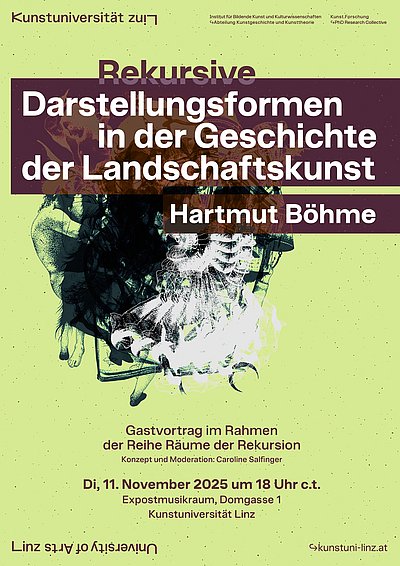Rekursive Darstellungsformen in der Geschichte der Landschaftskunst
November 11, 2025, 6 p.m. University of Arts Linz, Domgasse 1, Expostmusikraum, 4020 Linz
Recursive forms of representation in the history of landscape art
Lecture by Hartmut Böhme as part of the series Spaces of Recursion organized by the Department of Art History and Art Theory and the PhD Research Collective.
Since the Renaissance, image-immanent forms of representation have emerged that make the thesis likely that images began to think for themselves: the reflexive image, as developed by Victor Stoichiță. Images that make themselves the object; images that conceal their theory or manifest it openly; images that develop in infinite variations, destabilizing mimesis and realism; metapictural signs in images; motifs based on reflexive repetitions; images as traps, as deception or as play. The lecture will discuss these theoretical problems of an aesthetics of the recursive, which have only been hinted at here, using examples from art history.
Hartmut Böhme was Professor of Modern German Literature at the University of Hamburg from 1977-92 and Professor of Cultural Theory and History of Mentalities at the Humboldt University in Berlin from 1993-2012. He was often head of DFG research projects, e.g. spokesperson for the Collaborative Research Center "Transformations of Antiquity" (until 2012). Among other things, he publishes on the cultural history of nature and the elements and researches the history of art and science in the oral cavity. His cultural studies work includes Fetishism and Culture. A different Theory of Modernity hervorzuheben (2006/2014/2021). His other areas of specialization are cultural history since antiquity and the history of literature from the 18th to the 20th century. Other works are devoted to philosophy, aesthetics and art as well as historical anthropology. See also: www.hartmutboehme.de
The event series is organized by Caroline Salfinger (University of Art and Design Linz, PhD Research Collective and Art History and Theory) and supported by Anne von der Heiden (University of Art and Design Linz , Art History and Theory).
